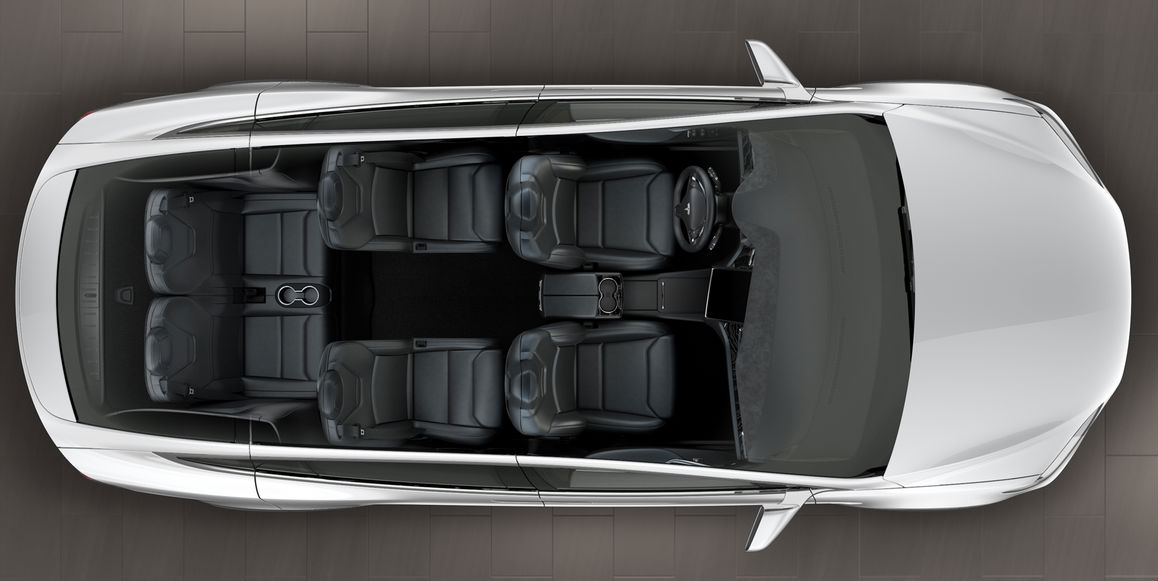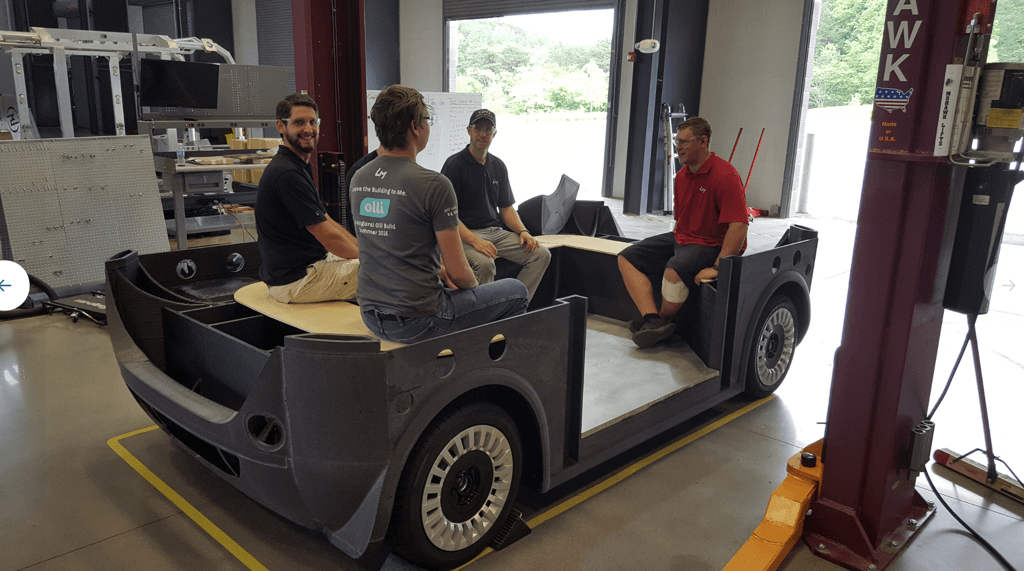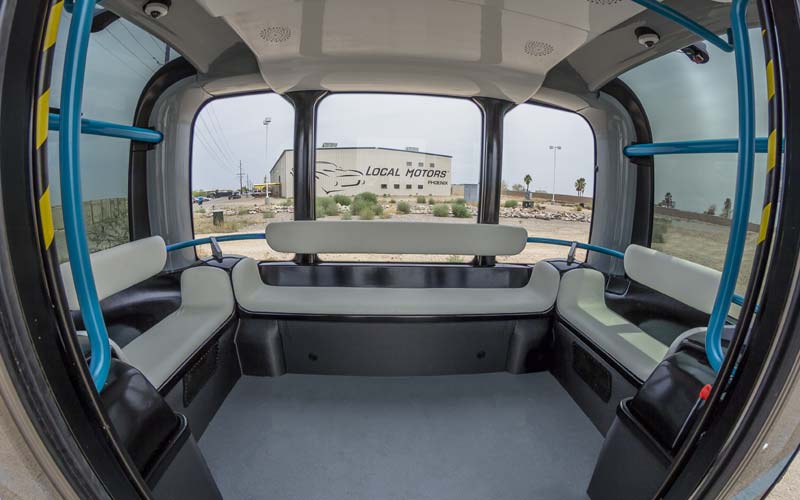Welcome to Tesla Motors Club
Discuss Tesla's Model S, Model 3, Model X, Model Y, Cybertruck, Roadster and More.
Register
Install the app
How to install the app on iOS
You can install our site as a web app on your iOS device by utilizing the Add to Home Screen feature in Safari. Please see this thread for more details on this.
Note: This feature may not be available in some browsers.
-
Want to remove ads? Register an account and login to see fewer ads, and become a Supporting Member to remove almost all ads.
You are using an out of date browser. It may not display this or other websites correctly.
You should upgrade or use an alternative browser.
You should upgrade or use an alternative browser.
Tesla i public transport bus
- Thread starter nico180
- Start date
-
- Tags
- Future Tesla
BioSehnsucht
Model 3 LR
I think the bus makes more sense in a world (or region) without the "Tesla Network", or one in which it doesn't take off enough to meet demand for "public" transport.
There could certainly be regions where a supplementary mini-bus fleet makes sense (possibly even handled through the same "Tesla Network" app, but Tesla or city owned, assuming the app can handle ride sharing people to multiple locations), though Elon seems to think that tunnels plus Tesla Network will make it moot.
There could certainly be regions where a supplementary mini-bus fleet makes sense (possibly even handled through the same "Tesla Network" app, but Tesla or city owned, assuming the app can handle ride sharing people to multiple locations), though Elon seems to think that tunnels plus Tesla Network will make it moot.
I think the bus makes more sense in a world (or region) without the "Tesla Network", or one in which it doesn't take off enough to meet demand for "public" transport.
There could certainly be regions where a supplementary mini-bus fleet makes sense (possibly even handled through the same "Tesla Network" app, but Tesla or city owned, assuming the app can handle ride sharing people to multiple locations), though Elon seems to think that tunnels plus Tesla Network will make it moot.
There's a big difference between service areas based on population density. Areas with low to moderate population density that often don't have much public transport anyway probably get along fine without specialized buses using Tesla Network.
Major cities still need mass transport. The vehicle needed is pretty much like what's shown as the glass pod in the video or google Olli by Local Motors, or the Video about Hyperloop Dubai shows similar pods loading into a Hyperloop.
The vehicle that everybody seems to arrive at is a boxy body tall enough to walk straight into and stand in but about the same footprint as would fit on a Model S/X size Skate. These pods are great replacements for larger buses because they move masses of people even more efficiently since they load/unload faster and waste less time on queues. Basically also like a glass elevator with wheels. These pods represent a containerization of human transport. The tunnel video shows them used with skates and tunnels. The Hyperloop Dubai video shows them used in Hyperloops and then driving off on their own on the highway. A further use might be with Thyssen-Krupp style vertical/horizontal elevators. Pods might also enter building elevator systems and circulate directly then exit the building, use surface streets, tunnel skates or Hyperloop to get to a new destination and go directly anywhere in that building.
These pods could also have local cargo deliver versions in the same size.
There is no way customer owned vehicles are a substitute for these pods in Urban areas, at least in the sense that traditional styles of vehicles aren't. Pods would work off of the same Tesla Network. Who owns these transport pods is as open a question as who owns any other vehicle on the network.
In the 1Q conference call today, Elon threw cold water on the bus concept. He gave a stream of consciousness ramble that was basically a back track on ever making a Tesla bus.
Even Elon misses things occasionally. He's got enough to think about. The VW minibus notion was always kind of pointless except in the same customer niche sense as the new Roadster. The Glass walled transport pod shown in the tunnel video is the idea. Similar to the pods shown in the Hyperloop Dubai video or Olli by Local Motors. They'd work on their own on surface Streets, on skates in tunnels, in Hyperloop, perhaps even in the new generation of elevator shafts. They containerize human transport and definitely could work with the Tesla Network.
These are for NewYork, London, Shanghai, not the suburbs. They're an obvious and critical part of urban transport using autonomous vehicles so hopefully Tesla is on the project more than just a few interns in the Boring Company project who get the point.
ItsNotAboutTheMoney
Well-Known Member
In the 1Q conference call today, Elon threw cold water on the bus concept. He gave a stream of consciousness ramble that was basically a back track on ever making a Tesla bus.
Although he was saying a bus wouldn't be worth it, he did suggest perhaps an X with more seats.
I just think he wants to focus on the tunnel thing, and it'd be much easier if the skate doesn't have to carry larger vehicles.
NeverFollow
Active Member
Major cities still need mass transport.
The vehicle needed is pretty much like what's shown as the glass pod in the video or google Olli by Local Motors,
or the Video about Hyperloop Dubai shows similar pods loading into a Hyperloop.
The vehicle that everybody seems to arrive at is a boxy body tall enough to walk straight into and stand in
but about the same footprint as would fit on a Model S/X size Skate.
These pods are great replacements for larger buses because they move masses of people even more efficiently
since they load/unload faster and waste less time on queues.
Basically also like a glass elevator with wheels.
These pods represent a containerization of human transport.
The tunnel video shows them used with skates and tunnels.
The Hyperloop Dubai video shows them used in Hyperloops and then driving off on their own on the highway.
A further use might be with Thyssen-Krupp style vertical/horizontal elevators.
Pods might also enter building elevator systems and circulate directly then exit the building,
use surface streets, tunnel skates or Hyperloop to get to a new destination
and go directly anywhere in that building.
Interesting concept, but with the following restriction:
1) If ALL the passengers are sitting, and may be wear a seat belt, then the pods can follow the traffic.
2) If there is any passenger standing up, then the pods will have
to move, accelerate, and slow down very very gently and carefully.
And avoiding a pedestrian or a bicycle could creates a real chaos inside.
In this case the pods would not be able to follow regular traffic flow
and will need to have their own right-of-way reserved lane.
In the following picture, the glassy pod concept looks more like an airport skyline train car than a real car or van:

NeverFollow
Active Member
The vehicle that everybody seems to arrive at is a boxy body tall enough to walk straight into
and stand in but about the same footprint as would fit on a Model S/X size Skate.
Can anyone could provides the exact size and sitting passengers capacity of the Olli Local Motors van?
Looking at a Tesla S/X, I can only see the possibility to add may be another seat row,
so there could be only a total of 8 to 12 (very narrow) possible seats.





2) If there is any passenger standing up, then the pods will have
to move, accelerate, and slow down very very gently and carefully.
You mean, standing up like on a city bus or commuter train?
NeverFollow
Active Member
You mean, standing up like on a city bus or commuter train?
Yes, the Tesla Pod shows a passenger standing up.
So looking at the Tesla skateboard or the Olli, it seems that you can only have 8 seats available
(and no standing up passenger) if you want the pod to move at the same speed as the others cars.

Last edited:
NeverFollow
Active Member
Honestly, I don't think that all those concepts of sledge car transportation or pods
can really solve rush congestions in big cities.
I still think that only light rail or subway trains can provide enough capacity to handle mass transit.


can really solve rush congestions in big cities.
I still think that only light rail or subway trains can provide enough capacity to handle mass transit.


Sean Wagner
Member
These pods represent a containerization of human transport.
I think this is an important insight, as international shipping really only took off with the standardization that containers provided. Look at containers as autonomous vehicles that require some infrastructure but dispense with the driver [human input] going from any point A to B. A simulation of smallish [10-20 people] driverless subway pods running on existing infrastructure would be fascinating.
Thanks for posting the pics. They capture the whole idea. The exact size isn't important...it's about the same footprint as a full size car or SUV and the critical difference is passengers don't have to get in and out like a car. They can stand and walk in and out. The space fits 8 sitting or 12 with standing room. It also accommodates a wheelchair or scooter.Can anyone could provides the exact size and sitting passengers capacity of the Olli Local Motors van?
Looking at a Tesla S/X, I can only see the possibility to add may be another seat row,
so there could be only a total of 8 to 12 (very narrow) possible seats.






Skates carrying cars no. Pods yes. Pods have every bit the capacity of city buses or light rail but more efficiently used. There's the same capacity divided into several pods that load and unload faster and can be deployed independently. If you have a busy train or bus stop, what's more efficient, a city bus or train that takes 4x as long to load and unload and arrives 1/4 as often or 4 pods of equal carrying capacity. The only efficiency of city buses or light rail is the reduction in the number of drivers needed which obviously is irrelevant with autonomous vehicles. Pods handle the peak crush Better and the light off hours better.Honestly, I don't think that all those concepts of sledge car transportation or pods
can really solve rush congestions in big cities.
I still think that only light rail or subway trains can provide enough capacity to handle mass transit.


This seems to be an emerging idea. A Pod is something about the same footprint as a car or SUV but boxy, autonomous and able to act as unit load in other transport modes. So it can travel on its own on city streets like Olli. It can also get on a Skate and travel in a tunnel at 200 kph. Or load into a Hyperloop pod and travel in near vacuum at much higher speeds. It might even be adapted to enter building elevator shafts like a vehicle in the Thyssen-Krupp system of horizontal/vertical elevators.I think this is an important insight, as international shipping really only took off with the standardization that containers provided. Look at containers as autonomous vehicles that require some infrastructure but dispense with the driver [human input] going from any point A to B. A simulation of smallish [10-20 people] driverless subway pods running on existing infrastructure would be fascinating.
Why? How is this any different from a city bus or streetcar where passengers can stand? I think the lack or bars or straps for people to hold onto in this rendering is just artistic license to give it cleaner lines. Olli has bars for support. On surface streets these would serve the same function as city buses and being able to carry standing passengers and load and unload quickly is an important feature. If the same pod was transitioned to higher speed or acceleration modes like the skate, I think you're right, passengers would have to be seated and use safety belts.Yes, the Tesla Pod shows a passenger standing up.
So looking at the Tesla skateboard or the Olli, it seems that you can only have 8 seats available
(and no standing up passenger) if you want the pod to move at the same speed as the others cars.

Here's the Hyperloop Dubai video depicting similar Pods loading onto and off a Hyperloop transport then going on the street on their own power. These Pods are depicted as more spacious and with different seating but the same idea of human transport containers.
Here's the Thyssen-Krupp horizontal-vertical elevator concept.
Seems a pretty good fit for a pod that can travel on its own on the street or get on a skate or use a Hyperloop transport to also be able to enter this system and circulate to where it's going inside buildings,
Sean Wagner
Member
Here's the Hyperloop Dubai video
Thank you, that's a slick presentation. I especially like the idea of parking pods in a ring for easy access. Maybe extending their modes of transport to include the vertical is a stretch for many buildings [but great where size and traffic volume warrant it] - on the other hand, building pods could seamlessly meet up with urban pods.
Now I've begun to ruminate about simulating an existing subway system running on autonomous pods the size of single [train] cars. Autonomous subway trains are already in use world wide, of course. Why not decouple? I'm sure the existing infrastructure can still be put to use - for instance, the New York subway is running way under capacity because the signalling on most lines is truly ancient.
One issue with adapting it to subway lines is their being built with stations along the line rather than on a bypass. Generally traffic can't flow around them the way it does on a street with multiple lanes.
New York is using very old technology on many lines. One thing this illustrates that's positive about tunnels is how they're a long term investment. The Tunnels themselves can last a lot longer than anything built on the surface and not being exposed to weather means a lot of equipment stays in use much longer too.
I don't think pods that enter elevator systems could be adapted to existing structures, but as you point out, they might easily interface. The sort of vehicle elevators the Tesla video depicts might emerge directly in the sub basement parking garages of buildings as well as on streets.
New York is using very old technology on many lines. One thing this illustrates that's positive about tunnels is how they're a long term investment. The Tunnels themselves can last a lot longer than anything built on the surface and not being exposed to weather means a lot of equipment stays in use much longer too.
I don't think pods that enter elevator systems could be adapted to existing structures, but as you point out, they might easily interface. The sort of vehicle elevators the Tesla video depicts might emerge directly in the sub basement parking garages of buildings as well as on streets.
Similar threads
- Replies
- 2
- Views
- 757
- Replies
- 2
- Views
- 161
- Replies
- 75
- Views
- 7K
- Replies
- 5
- Views
- 679





